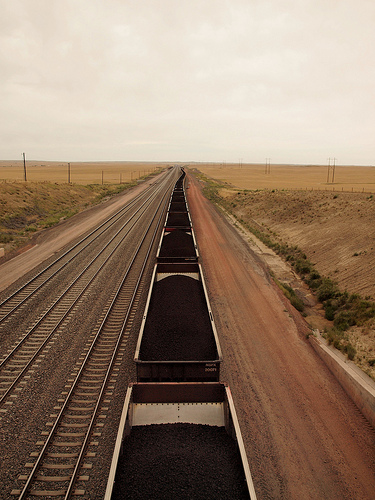As the Wall Street Journal reported recently, creditors of coal industry giant Alpha Natural Resources just hired a team of advisers to help them “restructure” the company’s debt—financial-speak for “next stop, bankruptcy!” And as the Journal points out, questions about the company’s massive environmental liabilities have played a major role in the company’s recent financial woes:
The company, which has posted four consecutive annual losses, disclosed in May that a Wyoming environmental agency notified the company it no longer qualified for a “self-bonding” program that had freed the company from buying insurance to cover future mine cleanup costs…[Alpha’s] rapid cash burn and potential costs tied to the loss of self-bonding status pose challenges to its balance sheet.
A couple of weeks ago, I explained what self-bonding is and why it matters so much to a coal company’s financial health.
But it’s not just coal investors who should be paying attention to self-bonding. We all should. Because If a struggling coal company like Arch or Alpha goes bankrupt, the public could have to pick up the cost of cleaning up their massive coal mines.
Here’s why.
Federal law requires coal mining companies to provide financial assurances, called “reclamation bonds,” to guarantee that strip mines will be cleaned up, or “reclaimed,” even if their owners go belly-up. Coal companies can back up these bonds with “sureties,” which are akin to insurance policies, or by setting aside cash or other assets to pay for cleanup.
But because bonding can be expensive, Congress allowed financially healthy companies to back up their reclamation obligations with little more than a wink and a promise, with no sureties or collateral required. These financial promises are called “self-bonds.”
The problem, though, is that the criteria for deciding whether a company is “financially healthy” are riddled with loopholes. The federal standards rely on a company’s balance sheet—the audited statements of assets and liabilities—to gauge financial health. But in today’s coal market, a balance sheet is virtually meaningless: it mostly reflects what a company paid for its assets, not what they’re actually worth. As I write this, for example, the total market value of Arch Coal stock sits below $70 million. But the company’s most recent balance sheet shows a “stockholder equity” of a whopping $1.6 billion—vastly larger than the company’s actual value in the marketplace.
In essence, then, federal rules rely on fictional assets to cover a real-world financial obligation.
Worse, the rules also allow a coal conglomerate to submit a subsidiary’s balance sheet as proof of financial solvency. As revealed by Reuters, coal mega-giants Arch Coal and Peabody Energy both use subsidiaries to self-bond. And the balance sheet of a subsidiary can look perfectly healthy, even if its parent corporation is loaded down with so much debt that it’s staring bankruptcy in the face. If that heavily indebted parent company does enter bankruptcy, it typically pulls all of its subsidiaries down with it. (See the two bankruptcies of Patriot Coal, and the James River bankruptcy, and Xinergy, and Trinity Coal…shall I continue?)
So what happens if—or when—one of these self-bonded companies does file for bankruptcy? It’s hard to know for sure, because bankruptcy cases are complicated. But there’s certainly no guarantee that a bankrupt firm will have enough assets to pay for mine cleanup. The original 1983 regulatory discussion admitted as much:
“In the event of bankruptcy, the regulatory authority would probably be in the position of an unsecured creditor…Bankruptcy proceedings are often lengthy and involved, and the regulatory authority could have to settle on less than 100% payment on the indemnity agreement [i.e., self-bond]. The regulatory authority may be left with insufficient funds to complete the reclamation plan and may have to obtain funds elsewhere to do so.” [Emphasis added.]
In short, if the coal company goes bankrupt, the state or federal governments—that is, we, the people—might have to pay to clean up the company’s messes.
And that’s why coal companies like self-bonding so much. It saves them money on insurance and keeps their capital liquid…all while pushing the financial risks for cleanup onto you and me.
Way back in 1983, when the regulations were established, regulators apparently couldn’t imagine that their carefully devised financial criteria could ever allow financially shaky companies to self-bond:
A self-bond is allowed both because there are enough assets to allow reclamation in case of bankruptcy, and because there is little probability of bankruptcy… OSM is aware that bankruptcy proceedings are lengthy and do not have great likelihood for successful total recovery by creditors. The criteria in final Section 800.23(b)(3)(i)-(iii) are intended to avoid…the acceptance of a self-bond from a company that would enter bankruptcy. [Emphasis added.]
And yet here we are, 32 years later, with more than $2 billion in self-bonds issued to companies with terrible credit ratings, collapsing stock prices, distressed assets…and “restructuring” advisers already on hand to help navigate the ever-growing risk of bankruptcy.









Chris Troth
An excellent presentation of the problem, Clark.
The key question going forward is whether these companies will be allowed to escape these liabilities in bankruptcy. Courts likely will be constrained by law to let them do so, so we will need to look to legislatures to potentially make sure that acquirers at bankruptcy must assume any liabilities that are not recovered in the restructuring.
These likely bankruptcies may happen in an interesting nexus with the political campaigns of the next year and a half.